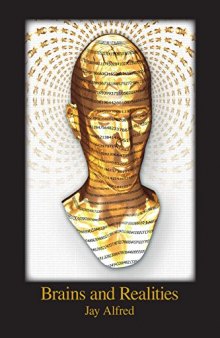دانلود کتاب Brains and Realities
by Jay Alfred|
|
عنوان فارسی: مغز و واقعیت |
 دانلود کتاب
دانلود کتاب
 جزییات کتاب
جزییات کتاب
there’ and that the brain constructs a world that is representative of this
world. But how do we prove that? Do we use our three- dimensional instruments
to probe and our three-dimensional consciousness to verify?
What exactly is out there?
Contrary to the conventional neuroscientific three-dimensional model,
cutting-edge physics tells us that the world ‘out there’ is multi-dimensional
and not solid but a cacophony of waveforms. The three-dimensional world
constructed by the brain is a reduction and a limited interpretation of what
is really out there. In Eastern religious philosophy and certain Western philosophies,
there is a bold assertion that what is out there is a paradoxical
‘full-void’ — i.e. a nothingness which contains everything. Apparently, this
void has been ‘experienced’ by mystics and advanced meditators — as recorded
quite extensively in religious scriptures and the metaphysical literature.
In this void, space and time are meaningless. The Surangama Sutra of
the Buddhists emphatically point out that location in space is illusionary.
Saint Augustine believed in an ever-present eternity which was not accessible
to humans. Both space and time may be illusions.
"Ultimately, all moments are really one. Therefore now is
eternity." (David Bohm, Physicist)
For a long time it was assumed that space and time were fundamental to
the underlying reality; but Einstein’s Theory of Special Relativity toppled
this assumption. What we observe as space and what we observe as time
are now regarded as two aspects of a more fundamental spacetime continuum.
To what extent this continuum manifests as space and how much of it
manifests as time varies according to the relative motion of the observer. In
other words, they are both subject to our perception within specific frames
of reference which provide three-dimensional frameworks to structure our
mental image of the world. But we are perhaps deceiving ourselves when we
assume that they are also fundamental to the underlying reality.
"Space and time are like the two lenses in a pair of glasses.
Without the glasses we could see nothing. The actual world,
the world external to our minds, is not directly perceivable;
we see only what is transmitted to us by our space-time
spectacles. The real object, what Kant called the ‘Thing-in-
Itself’, is transcendent, beyond our space-time, completely
unknowable… Perceptions are in, in a sense, illusions. They
are shaped and colored by our subjective sense of space and
time." (Martin Gardner, Mathematician)
Advances in Brain Science
Recently, science has made significant advances in studying the brain during
meditative states. Using cutting-edge medical imaging methods, observations
have been made of specific areas in the brain which are activated or
deactivated during meditation. It has also been widely observed that many
meditative traditions emphasise the activation and development of the right
hemisphere of the brain. In fact, certain studies have shown that various
areas in the right hemisphere grow thicker with regular meditation.
Is it possible to modify the operation of the brain to allow a meditator
to experience a totally different reality? Can we bypass the brain’s constructions
to reach a more fundamental reality? It is becoming increasingly
evident that we are blocked by our perceptual apparatus from experiencing
a more primordial reality. Hence, it would make sense to look at how the
human brain processes information to understand better the models that
it uses to construct its interpretation of the underlying reality; while being
limited by its own processing power and capabilities.
"I still believe the universe has a beginning in real time, at the
big bang. But there’s another kind of time, imaginary time,
at right angles to real time, in which the universe has no
beginning or end." (Stephen Hawking)
The Journey
We will begin the journey by first discussing the different methods of
processing sensory information in the right and left hemispheres of the human
brain. We will then explore what happens to the brain during mystical
experiences as revealed by recent medical studies. After this, we will take a
look at what modern physics tells us of the nature of the universe or multiverse,
comparing it with what mystics have said about it.
We will then propose the astonishing hypothesis that the experiences
of mystics are reconcilable to modern physics; and that the brain can be
made to experience a more fundamental reality where space and time do not
operate. Descriptions of this reality recorded in religious and metaphysical
literature will be reviewed, alongside descriptions from modern physics.
Then we will proceed to see how the human brain connects to parallel
universes and review its non-local nature. Readers will however note an undercurrent
of questions regarding the nature and future of Science and how
it can be reconciled to the totality of human experience. Science parted ways
with Religion more than 500 years ago, shaking-off the dust of centuries of
non-verified claims and superstitions. Will it be reunited with Religion’s inner
essence and wisdom in the next 500 years?







 این کتاب رو مطالعه کردید؟ نظر شما چیست؟
این کتاب رو مطالعه کردید؟ نظر شما چیست؟
